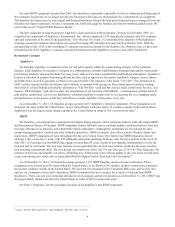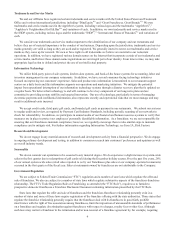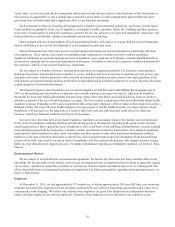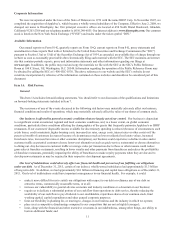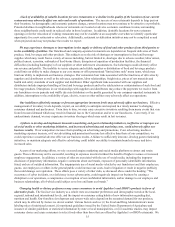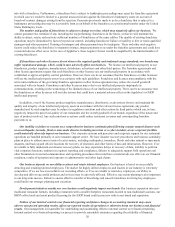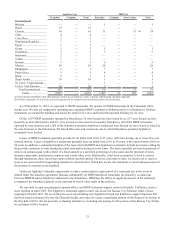IHOP 2015 Annual Report Download - page 34
Download and view the complete annual report
Please find page 34 of the 2015 IHOP annual report below. You can navigate through the pages in the report by either clicking on the pages listed below, or by using the keyword search tool below to find specific information within the annual report.14
Many factors, including those over which we have no control, affect the trading volatility and price of our stock. Many
factors, in addition to our operating results, may have an impact on the trading volatility and price of our common stock. These
factors include general economic and market conditions, publicity regarding us, our competitors, or the restaurant industry
generally, changes in financial estimates by securities analysts, changes in financial or tax reporting and accounting principles
or practices, trading activity in our common stock, and the impact of our capital allocation initiatives, including any future
stock repurchase programs or dividend declarations. A number of these factors are outside of our control, and any failure to
meet market expectations whether for sales growth, earnings per share or other metrics could cause our share price to decline.
Our actual operating and financial results in any given period may differ from guidance we provide to the public,
including our most recent public guidance. From time to time, in press releases, SEC filings, public conference calls and
other contexts, we have provided guidance to the public regarding current business conditions and our expectations for our
future financial results. We expect that we will provide guidance periodically in the future. Our guidance is based upon a
number of assumptions, expectations and estimates that are inherently subject to significant business, economic and
competitive uncertainties and contingencies, many of which are beyond our control. In providing our guidance, we also make
various assumptions with respect to our future business decisions, some of which will change. Our actual financial results,
therefore, may vary from our guidance due to our inability to meet the assumptions upon which our guidance is based and the
impact on our business of the various risks and uncertainties described in these risk factors and in our public filings with the
SEC. Variances between our actual results and our guidance may be material. To the extent that our actual financial results do
not meet or exceed our guidance, the trading prices of our securities may be materially adversely affected.
Our business strategy may not achieve anticipated results. We expect to continue to apply a business strategy that
includes, among other things: (i) operation of a 99% franchised restaurant system; (ii) the maintenance of a purchasing
cooperative that procures products and services for our Applebee's and IHOP restaurants; (iii) the possible introduction of new
restaurant concepts; and (iv) the continued implementation of a shared service model across the brands for various functions,
including legal, human resources, communications, quality assurance, information technology, finance and centers of
excellence in consumer insights/brand analytics, development and operations support. There can be no assurance that the
business strategy we apply to one franchise system will be suitable or will achieve results similar to the application of such
business strategy to the other franchise system. In addition, our operational improvement, purchasing and other strategic
initiatives may not be successful or achieve the desired results. In particular, there can be no assurance that the existing
franchisees or prospective new franchisees will respond favorably to such initiatives.
Our performance is subject to risks associated with the restaurant industry, including the highly competitive nature of
the industry. We derive a substantial portion of our revenues in the form of royalties based on a percentage of the gross sales
of our franchised restaurants. Sales and profitability of these restaurants and, in turn, payments we receive from our
franchisees may be negatively impacted by a number of factors, some of which are outside of our control. These factors
include:
• declines in comparable-restaurant sales growth rates due to: (i) failing to meet or adequately adapt to changing
customers' expectations for the quality of food and taste or to innovate new menu items to retain the existing customer
base and attract new customers; (ii) competitive intrusions in our markets; (iii) opening new restaurants that
cannibalize the sales of existing restaurants; (iv) failure of national or local marketing to be effective; (v) weakening
national, regional and local economic conditions; and (vi) natural or man-made disasters or adverse weather
conditions;
• negative trends in operating expenses such as: (i) increases in food costs including rising commodity costs;
(ii) increases in labor costs including increases mandated by minimum wage and other employment laws, immigration
reform, the potential impact of union organizing efforts, increases due to tight labor market conditions and the Patient
Protection and Affordable Care Act; and (iii) increases in other operating costs including advertising, utilities, lease-
related expenses and credit card processing fees;
• the highly competitive nature of the restaurant industry with respect to, among other things: (i) price, service, location,
personnel and the type and quality of food; (ii) the trend toward convergence in grocery, deli and restaurant services,
as well as the continued expansion of restaurants in the breakfast daypart; and (iii) the entry of major market players in
non-competing industries into the food services market which could decrease the market share of Applebee’s and
IHOP in their respective categories;
• the inability to open new restaurants that achieve and sustain acceptable sales volumes;
• the inability to increase menu pricing to offset increased operating expenses;
• failure to effectively manage further penetration into mature markets;
• negative trends in the availability of credit and in expenses such as interest rates and the cost of construction materials
that will affect our ability or our franchisees' ability to maintain and refurbish existing restaurants; and
• the inability to operate effectively in new and/or highly competitive geographic regions or local markets in which our
franchisees have limited operating experience.


